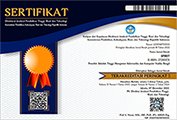PEMANFAATAN ARTIFICIAL NEURAL NETWORK DENGAN METODE HEBB RULE UNTUK PENGENALAN BAHASA ISYARAT INDONESIA STATIS
Abstract
Full Text:
PDF (Bahasa Indonesia)References
DAFTAR PUSTAKA
Andono, P. N., Sutojo, T., & Muljono. (2017). PENGOLAHAN CITRA DIGITAL. Yogyakarta: ANDI (Anggota IKAPI).
Budi, A., Suma'inna, & Maulana, H. (2016). Pengenalan Citra Wajah Sebagai Identifier Menggunakan Metode Principal Component Analysis
(PCA). JURNAL TEKNIK INFORMATIKA VOL 9 NO. 2, 1-9.
Delsavonita, & Candra, F. (2018). SISTEM PENGENALAN POLA KARAKTER HURUF KOREA MENGGUNAKAN METODE PRINCIPAL COMPONENT ANALYSIS DAN JARINGAN SYARAF TIRUAN - BACK PROPAGATION. Jom FTEKNIK Volume 5 Edisi 2 Juli s/d Desember 2018, 1-8.
Fadhilla, M., Saf, M. R., & Sahid, D. S. (2017). Pengenalan Kepribadian Seseorang Berdasarkan Pola Tulisa Tangan Menggunakan Jaringan Syaraf Tiruan. JNTETI, Vol 6, No.3, 1-9.
Faridh, H. M. (2013). Pengenalan Karakter Huruf Tulisan Tangan Menggunakan Metode Principle Component Analysis. 6.
Fathia, S. (2013). Dampak Reduksi Sample Menggunakan Principle Component Analysis (PCA) Pada Pelatihan Jaringan Syaraf Tiruan Terawasi (Studi Kasus : Pengenalan Angka Tulisan Tangan). 9.
Fatta, H. A. (2009). Rekayasa Sistem Pengenalan Wajah. Yogyakarta: C.V Andi Offset.
Hermawan, A. (2006). Jaringan Syaraf Tiruan.
Kong, X., Hu, C., & Duan, Z. (2017). Principal Component Analysis Network And Algorithms. Beijing: Science Press.
Muliono, R., & Lubis, J. H. (2018). Jaringan Syaraf Tiruan Pengenalan pola Huruf Dengan Jaringan Hebb. Jurnal Teknik Informatika Kaputama (JTIK) Vol 2, No. 1, 1-5.
Muliono, R., & Lubis, J. H. (2018). Jaringan Syaraf Tiruan Pengenalan Pola Huruf Dengan Jaringan Hebb. Jurnal Teknik Informatika Kaputama (JTIK) Vol. 2, No. 1, 1-5.
Mulyana, T. M. (2015). SEGMENTASI CITRA MENGGUNAKAN HEBB-RULE. JURNAL TEKNOLOGI INFORMASI, VOLUME 11, NOMOR 1, 1-9.
Algoritma Principal Component Analysis. 11, 11.
Tjolleng, A. (2017). Pengantar Pemrograman Matlab. Jakarta: PT. Elex Media Komputindo.
DOI: http://dx.doi.org/10.53567/spirit.v12i1.148
Refbacks
- There are currently no refbacks.
Copyright (c) 2020 Jurnal SPIRIT
Diindeks Oleh:
SPIRIT : Sarana Penunjang Informasi Terkini
Diterbitkan oleh Teknologi Informasi Institut Teknologi dan Bisnis Yadika Pasuruan
Alamat Redaksi: Jl. Bader No.9, Kwangsan, Kalirejo, Kec. Bangil, Pasuruan, Jawa Timur 67153
Telp/Fax: (0343) 742070 , Email : lppm@stmik-yadika.ac.id
Google Maps : Klik Disini

Karya ini dilisensikan di bawah Lisensi Internasional Creative Commons Atribusi 4.0 .







1.png)







